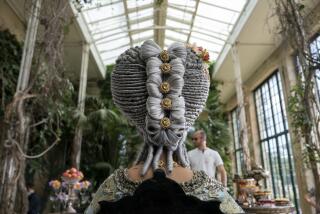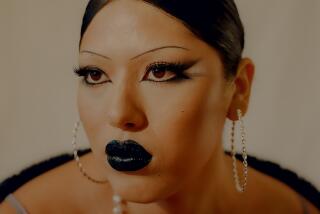Growing Pains : Careful Styling Can Help Ease the Transition From Short Hair to Long
- Share via
WHEN HEMLINE fads shift from thigh to knee to ankle, the simple secret to looking fashionable is having three black skirts, one in each length. But when hair trends drop from ear-skimming crops to longer, softer styles--which is precisely what’s happening now--there’s no easy way to stay in fashion.
The short, little-boy cuts of last year are beginning to look tired--”last decade,” as fashion folk put it. And the signs of change are everywhere. Although some Paris models wore abbreviated cuts at the spring shows, most sported longer, wavier and generally more feminine styles. In the latest issues of Vogue and Harper’s Bazaar, supermodel Linda Evangelista, who started the latest short-sheared craze, is wearing her dark brown hair over her ears and longer at the crown and in back.
In Southern California, women with short hair are talking about slightly longer haircuts, too. “Especially the trend-setters,” says Blase, a hairdresser at Beverly Hills’ Juan Juan salon. “When they see that everyone is wearing their look, they want something newer.”
But to go from pixie to pageboy takes time. The average head of hair grows half an inch per month, Blase points out, and it should be trimmed at least a quarter-inch every five to six weeks. “So if you start from very short right now, you can have a nice chin-length style by the holidays,” he says.
Hairdresser Allen Edwards, who has six Southern California salons, including shops in Beverly Hills, Long Beach and Irvine, agrees that getting a haircut every four to five weeks will ease the growing-out process. “There should be a new look for each new length,” Edwards says. “There is always a hair style that will suit a woman’s face, no matter how long or short her hair is. She shouldn’t have to wait for her hair to get longer to look good.”
Achieving a one-length style from a layered cut requires frequent trimming of the sides and back while the crown and bangs get longer. But the resulting blunt, geometric look is probably too sophisticated for today’s casual fashions. “Rather than have the perimeter of the hair straight, it’s newer to keep it uneven--it’s much more casual,” says Geri Cusenza of Sebastian International in Woodland Hills. Cusenza, who is letting her own dark brown locks grow out, wears spit curls and wispy bangs but keeps the rest of her hair layered to look its thickest.
Edwards also recommends a shaggier transition look with a fringe of bangs, calling it more feminine and less severe. Blase perms hair to achieve more softness around the face while the hair gets longer, but never before it’s about four inches long at the crown. “Otherwise, the style will look too round on top,” he cautions.
But other stylists believe that most clients want their hair to look as long as possible as fast as possible. Hairobics Salon owner George Caroll of Toluca Lake discourages perms or the use of round styling brushes to curl hair under because both tend to make the hair seem shorter. Instead, he teaches clients to use a flexible plastic brush he has designed that straightens the hair during blow-drying, giving the illusion of longer hair. “But you need to trim the ends frequently to keep the hair looking its thickest and neatest,” he says.
For women who refuse to spend the time and money for frequent trims or a perm, gels and pomades help to tame the hairs that tend to stick out around the ears. Cusenza, whose company manufactures styling products, prefers light aerosol gels to mousses, which make the hair stiff. “Everything about the new, longer styles is light and feminine, and mousses make the styles look too heavy,” she says.
Some women deal with the vagaries of hair fashion the same way European runway models do: They wear wigs. New synthetic wigs and falls in short, wavy styles cost about $150 and provide an instant hairdo.
There are, however, times when even a wig can’t satisfy the needs of the most impatient woman. But enduring the transition, whether it’s weeks or months, does have its hidden benefit. It allows a woman to determine which length best suits her features.
“I’ve seen women grow hair to their shoulders,” says Edwards, “then turn around and cut it all off again because they decide they like the way a short style frames their face.”






